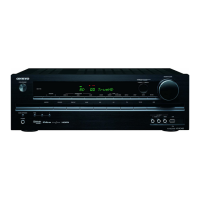Turning On & Basic Operations
En-28
■ Onkyo-Original DSP Listening Modes
Listening Mode Description Input
Source
Speaker
Layout
Orchestra
*1
Suitable for classical or operatic music, this
mode emphasizes the surround channels in
order to widen the stereo image, and
simulates the natural reverberation of a large
hall.
A
S
D
F
C
Unplugged
*1
Suitable for acoustic instruments, vocals,
and jazz, this mode emphasizes the front
stereo image, giving the impression of being
right in front of the stage.
Studio-Mix
*1
Suitable for rock or pop music, listening to
music in this mode creates a lively sound
field with a powerful acoustic image, like
being at a club or rock concert.
TV Logic
*1
This mode adds realistic acoustics to TV
shows produced in a TV studio, surround
effects to the entire sound, and clarity to
voices.
Game-RPG
*1
In this mode, the sound has a dramatic feel
with a similar atmosphere to Orchestra
mode.
Game-Action
*1
In this mode, sound localization is distinct
with emphasis on bass.
Game-Rock
*1
In this mode, sound pressure is emphasized
to heighten live feel.
Game-Sports
*1
In this mode, reverberation is increased and
sound localization decreased slightly.
All Ch Stereo Ideal for background music, this mode fills
the entire listening area with stereo sound
from the front and surround speakers.
XC
Full Mono In this mode, all speakers output the same
sound in mono, so the sound you hear is the
same regardless of where you are within the
listening room.
Or c es t rah
Unp uggedl
Stu io– Mi xd
TV og i cL
Gam – R P Ge
Gam –Ac t i one
Gam –Ro c ke
Gam –Ro c ke
Gam – S p or tse
Al l Ch Stereo
Fu l Monol
T-D (Theater-
Dimensional)
*1
With this mode you can enjoy a virtual
surround sound even with only two or three
speakers. This works by controlling how
sounds reach the listener’s left and right ears.
Good results may not be possible if there’s
too much reverb, so we recommend that you
use this mode in an environment with little
or no natural reverb.
A
S
D
F
ZXC
Listening Mode Description Input
Source
Speaker
Layout
T – D

